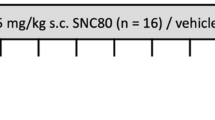Abstract
The potential contribution of dorsal bundle norepinephrine (NE) in the induction of escape disturbances engendered by inescapable shock was evaluated following administration of the NE neurotoxin, DSP4. Treatment with DSP4 produced marked NE reductions in the hippcampus and cortex, a moderate reduction of NE in the locus coeruleus, but only small effects on hypothalamic NE. In contrast to the effect of inescapable shock, DSP4 was found not to influence escape behavior among naive mice or mice that had received inescapable shock. Moreover, DSP4 was without effect on escape performance irrespective of whether animals were individually or group housed, a treatment that has been shown to be sensitive to manipulations that influence escape performance. Treatment with DSP4 was found not to influence the escape interference ordinarily provoked by either haloperidol or α-MpT. Interestingly, the escape interference ordinarily engendered by the dopamine-β-hydroxylase inhibitor, FLA-63, was eliminated among mice that had been pretreated with DSP4. The interference effect induced by inescapable shock is probably not attributable to NE alterations in the hippocampus and locus coeruleus. Serial or parallel effects of shock on more than a single transmitter system are likely to be responsible for the behavioral interference.
Similar content being viewed by others
References
Anisman H (1982) Neurochemical consequences of stress: Intrusion of nonassociative factors in behavioral analysis. In: Isaacson RL, Spear NE (eds) The expression of knowledge. Plenum Press, New York
Anisman H, Sklar LS (1981) Social housing conditions influence escape deficits produced by uncontrollable stress: Assessment of the contribution of norepinephrine. Behav Neur Biol 32:406–427
Anisman H, de Catenzaro D, Remington LS (1978) Escape performance following exposure to inescapable shock: Deficits in motor response maintenance. J Exp Psychol [Anim Behav] 4:197–218
Anisman H, Remington G, Sklar LS (1979a) Effects of inescapable shock on subsequent escape performance: Catecholaminergic and cholinergic mediation of response initiation and maintenance. Psychopharmacology 61:107–124
Anisman H, Irwin J, Sklar LS (1979b) Deficits of escape performance following catecholamine depletion: Implications for behavioral deficits induced by uncontrollable stress. Psychopharmacology 64:163–170
Anisman H, Kokkinidis L, Sklar LS (1981a) Contribution of neurochemical change to stress-induced behavioral deficits. In: Cooper S (ed) Theory in psychopharmacology, vol 1. Academic Press, London
Anisman H, Ritch M, Sklar LS (1981b) Noradrenergic and dopaminergic interactions in escape behavior: Analysis of uncontrollable stress effects. Psychopharmacology 74:263–268
Anisman H, Irwin J, Beauchamp C, Zacharko RM (1983) Crossstressor immunization against the behavioral deficits introduced by uncontrollable shock. Behav Neurosci 97:452–461
Archer T (1982) DSP4 (N-2-chloroethyl-N-ethyl-2-bromobenzylamine) a new noradrenergic neurotoxin and stimulus conditions affecting acquisition of two-way active avoidance. J Comp Physiol Psychol 96:476–488
Blanc G, Herve D, Simon H, Lisoprawski A, Glowinski J, Tassin JP (1980) Response to stress of mesocortico-frontal dopaminergic neurones in rats after long-term isolation. Nature 284:265–267
Bruto V, Beauchamp C, Zacharko RM, Anisman H (1984) Amphetamine-induced perseverative behavior in a radial arm maze following DSP4 or 6-OHDA pretreatment. Psychopharmacology 83:62–69
Glazer HI, Weiss JM, Pohorecky LA, Miller NE (1975) Monoamines as mediators of avoidance-escape behavior. Psychosom Med 37:535–543
Herman JP, Guillonneau D, Dantzer RR, Scatton B, Semerdjian-Rouquier L, LeMoal M (1982) Differential effects of inescapable footschocks and stimuli previously paired with inescapable footschocks on dopamine turnover in cortical and limbic areas of the rat. Life Sci 30:2207–2214
Jaim-Etcheverry G, Zieher LM (1980) DSP-4: A novel compound with neurotoxic effects on noradrenergic neurons of adult and developing rats. Brain Res 188:513–523
Jonsson G, Hallman H, Ponzio F, Ross S (1981) DSP4 (N-(2-chloroethyl)-N-ethyl-2-bromobenzylamine — A useful denervation tool for central and peripheral noradrenaline neurons. Eur J Pharm 72:173–188
Kobayashi RM, Palkovits M, Kizer JS, Jacobowitz DM, Kopin IJ (1976) Selective alterations of catecholamines and tyrosine hydroxylase activity in the hypothalamus following acute and chronic stress. In: Usdin E, Kvetnansky R, Kopin IJ (eds) Catecholamines and stress. Pergamon Press, Oxford
Laverty R, Taylor KM (1968) The fluorometric assay for catecholamines and related compounds: Improvements and extensions of the hydroxyindole technique. Anal Biochem 22:269–279
Maickel RF, Cox RH Jr, Saillant J, Miller FP (1968) A method for the determination of serotonin and norepinephrine in discrete areas of rat brain. Int J Neuropharm 7:275–281
Maier SF, Seligman MEP (1976) Learned helplessness: Theory and evidence. J Exp Psychol [Gen] 105:3–46
Mason ST, Fibiger HC (1979) Noradrenaline and avoidance learning in the rat. Brain Res 161:321–334
Nakagawa R, Tanaka M, Kohno Y, Noda Y, Nagasaki N (1981) Regional responses of rat brain noradrenergic neurons to acute intense stress. Pharm Biochem Behav 14:729–732
Ogren SO, Archer T, Ross SB (1980) Evidence for a role of the locus coeruleus noradrenaline system in learning. Neurosci Lett 20:351–356
Saavedra JM (1982) Changes in dopamine, noradrenaline and adrenaline in specific septal and preoptic nuclei after acute immobilization stress. Neuroendocrinology 35:396–401
Sherman AD, Petty F (1980) Neurochemical basis of the action of antidepressants on learned helplessness. Behav Neural Biol 263:242–244
Weiss JM, Glazer HI, Pohorecky LA (1976) Coping behavior and neurochemical changes: An alternative explanation for the original “learned helplessness” experiments. In: Serban G, Kling A (eds). Animal models in human psychobiology. Plenum Press, New York
Weiss JM, Goodman PA, Losito BG, Corrigan S, Charry JM, Bailey WH (1981) Behavioral depression produced by an uncontrolable stressor: Relationship to norepinephrine, dopamine and serotonin levels in various brain regions of rat brain. Brain Res 3:161–191
Author information
Authors and Affiliations
Rights and permissions
About this article
Cite this article
Anisman, H., Beauchamp, C. & Zacharko, R.M. Effects of inescapable shock and norepinephrine depletion induced by DSP4 on escape performance. Psychopharmacology 83, 56–61 (1984). https://doi.org/10.1007/BF00427423
Received:
Accepted:
Issue Date:
DOI: https://doi.org/10.1007/BF00427423




